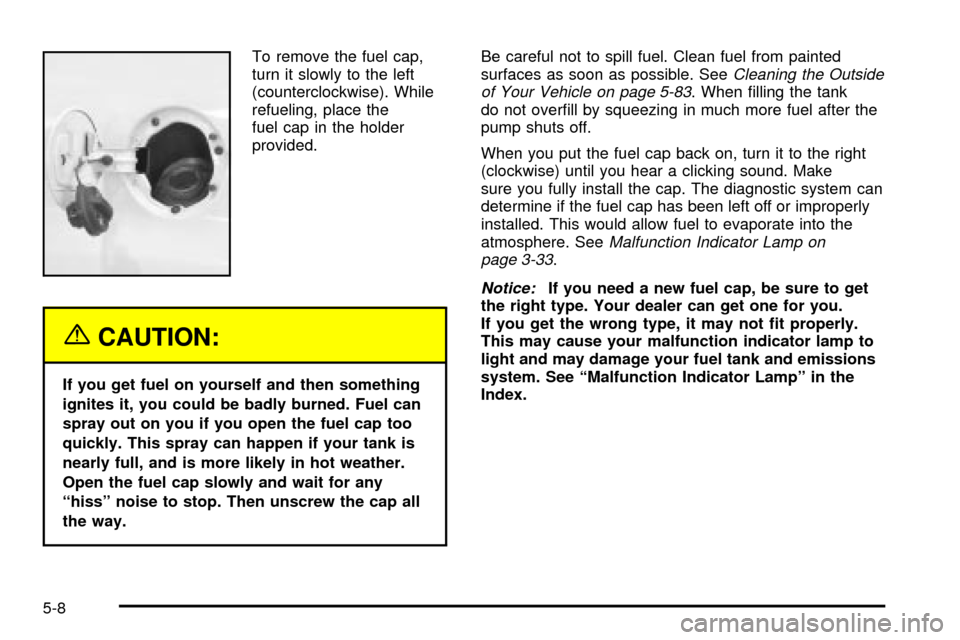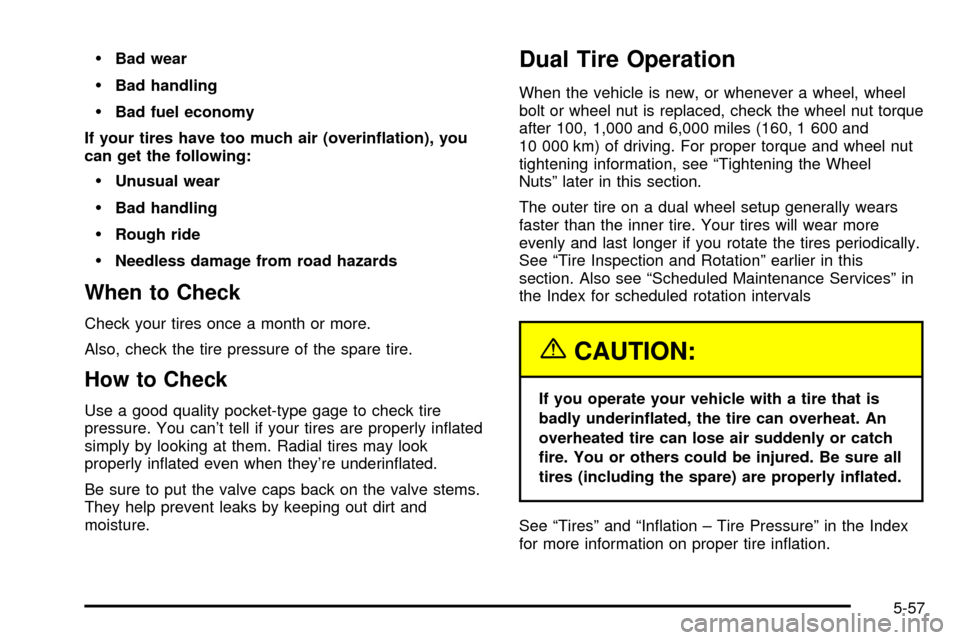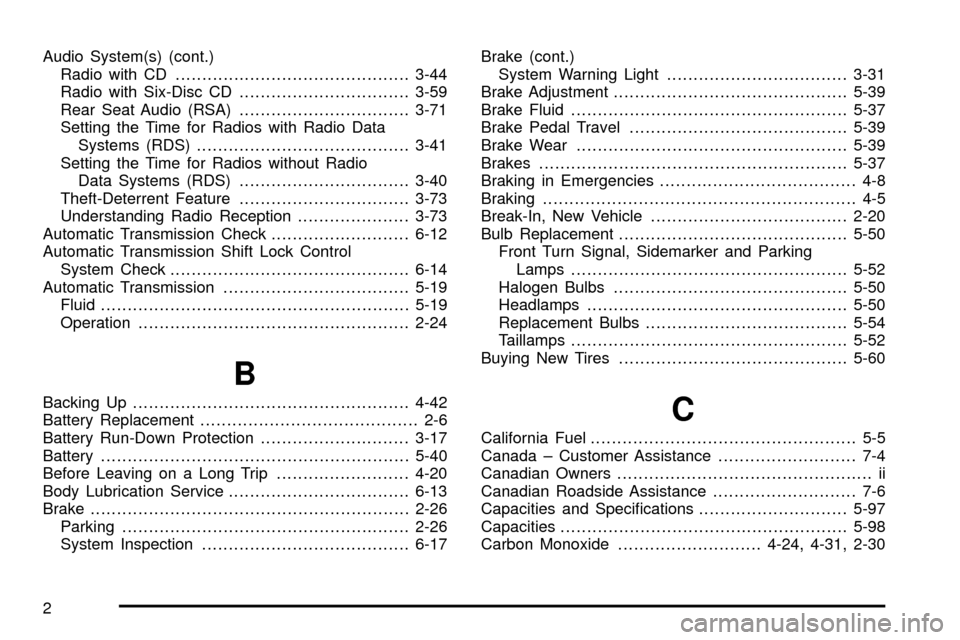Page 277 of 386
Filling Your Tank
{CAUTION:
Fuel vapor is highly ¯ammable. It burns
violently, and that can cause very bad injuries.
Don't smoke if you're near fuel or refueling
your vehicle. Keep sparks, ¯ames and smoking
materials away from fuel.The fuel cap is located
behind a hinged door on
the driver's side of
your vehicle.
5-7
Page 278 of 386

To remove the fuel cap,
turn it slowly to the left
(counterclockwise). While
refueling, place the
fuel cap in the holder
provided.
{CAUTION:
If you get fuel on yourself and then something
ignites it, you could be badly burned. Fuel can
spray out on you if you open the fuel cap too
quickly. This spray can happen if your tank is
nearly full, and is more likely in hot weather.
Open the fuel cap slowly and wait for any
ªhissº noise to stop. Then unscrew the cap all
the way.Be careful not to spill fuel. Clean fuel from painted
surfaces as soon as possible. See
Cleaning the Outside
of Your Vehicle on page 5-83. When ®lling the tank
do not over®ll by squeezing in much more fuel after the
pump shuts off.
When you put the fuel cap back on, turn it to the right
(clockwise) until you hear a clicking sound. Make
sure you fully install the cap. The diagnostic system can
determine if the fuel cap has been left off or improperly
installed. This would allow fuel to evaporate into the
atmosphere. See
Malfunction Indicator Lamp on
page 3-33.
Notice:If you need a new fuel cap, be sure to get
the right type. Your dealer can get one for you.
If you get the wrong type, it may not ®t properly.
This may cause your malfunction indicator lamp to
light and may damage your fuel tank and emissions
system. See ªMalfunction Indicator Lampº in the
Index.
5-8
Page 283 of 386
A. Battery
B. Radiator Pressure Cap
C. Coolant Recovery Tank
D. Transmission Fluid Dipstick
E. Engine Oil Fill
F. Engine Oil Dipstick
G. Air Filter Restriction Indicator
H. Engine Air Cleaner/Filter
I. Power Steering Reservoir
J. Brake Master Cylinder
K. Windshield Washer Fluid
Engine Oil
Checking Engine Oil
It's a good idea to check your engine oil every time you
get fuel. In order to get an accurate reading, the oil
must be warm and the vehicle must be on level ground.The engine oil dipstick has
a yellow handle and is
located near the center of
the engine compartment.
See
Engine Compartment
Overview on page 5-12
for more information
on location.
Turn off the engine and give the oil several minutes to
drain back into the oil pan. If you don't, the oil
dipstick might not show the actual level.
Pull out the dipstick and clean it with a paper towel or
cloth, then push it back in all the way. Remove it again,
keeping the tip down, and check the level.
5-13
Page 327 of 386

·Bad wear
·Bad handling
·Bad fuel economy
If your tires have too much air (overin¯ation), you
can get the following:
·Unusual wear
·Bad handling
·Rough ride
·Needless damage from road hazards
When to Check
Check your tires once a month or more.
Also, check the tire pressure of the spare tire.
How to Check
Use a good quality pocket-type gage to check tire
pressure. You can't tell if your tires are properly in¯ated
simply by looking at them. Radial tires may look
properly in¯ated even when they're underin¯ated.
Be sure to put the valve caps back on the valve stems.
They help prevent leaks by keeping out dirt and
moisture.
Dual Tire Operation
When the vehicle is new, or whenever a wheel, wheel
bolt or wheel nut is replaced, check the wheel nut torque
after 100, 1,000 and 6,000 miles (160, 1 600 and
10 000 km) of driving. For proper torque and wheel nut
tightening information, see ªTightening the Wheel
Nutsº later in this section.
The outer tire on a dual wheel setup generally wears
faster than the inner tire. Your tires will wear more
evenly and last longer if you rotate the tires periodically.
See ªTire Inspection and Rotationº earlier in this
section. Also see ªScheduled Maintenance Servicesº in
the Index for scheduled rotation intervals
{CAUTION:
If you operate your vehicle with a tire that is
badly underin¯ated, the tire can overheat. An
overheated tire can lose air suddenly or catch
®re. You or others could be injured. Be sure all
tires (including the spare) are properly in¯ated.
See ªTiresº and ªIn¯ation ± Tire Pressureº in the Index
for more information on proper tire in¯ation.
5-57
Page 367 of 386
Capacities and Speci®cations
All capacities are approximate. When adding, be sure to ®ll to the appropriate level or as recommended in this
manual.
See refrigerant charge label under the hood for charge capacity information and requirements.
Engine Speci®cations
Engine VIN Code Transmission Spark Plug Gap Firing OrderWheel Nut
Torque
VORTECŸ 4300 V6
MFI
1W M300.060 inches
(1.52 mm)1±6±5±4±3±2140 lb ft
190Y
VORTECŸ 4800 V8
MFI
1V MT10.060 inches
(1.52 mm)1±8±7±2±6±5±4±3140 lb ft
190Y
VORTECŸ 5300 V8
MFI
1T M300.060 Inches
(1.52 mm)1±8±7±2±6±5±4±3140 lb ft
190Y
VORTECŸ 6000 V8
MFI
1U MT10.060 inches
(1.52 mm)1±8±7±2±6±5±4±3140 lb ft
190Y
1Sequential Fuel Injection
5-97
Page 369 of 386
ApplicationCapacities
QTY Without Rear
Heater QTY With Rear Heater
Fuel Tank
Standard Tank (Passenger and Cargo) 31.0 gallons 117.3 L
Standard Tank (Cab and Chassis) 35.0 gallons 132.5 L
Optional Tank* (Cab and Chassis) 55.0 gallons 208.1 L
* 159 inch wheelbase or 177 inch wheel base only
Air Conditioning Refrigerant Capacity
Air Conditioning Refrigerant R-134a (Front) 1.8 lbs (0.81 kg)
Air Conditioning Refrigerant R-134a (Front and Rear) 3.1 lbs (1.41 kg)
5-99
Page 372 of 386

Audio System(s) (cont.)
Radio with CD............................................3-44
Radio with Six-Disc CD................................3-59
Rear Seat Audio (RSA)................................3-71
Setting the Time for Radios with Radio Data
Systems (RDS)........................................3-41
Setting the Time for Radios without Radio
Data Systems (RDS)................................3-40
Theft-Deterrent Feature................................3-73
Understanding Radio Reception.....................3-73
Automatic Transmission Check..........................6-12
Automatic Transmission Shift Lock Control
System Check.............................................6-14
Automatic Transmission...................................5-19
Fluid..........................................................5-19
Operation...................................................2-24
B
Backing Up....................................................4-42
Battery Replacement......................................... 2-6
Battery Run-Down Protection............................3-17
Battery..........................................................5-40
Before Leaving on a Long Trip.........................4-20
Body Lubrication Service..................................6-13
Brake............................................................2-26
Parking......................................................2-26
System Inspection.......................................6-17Brake (cont.)
System Warning Light..................................3-31
Brake Adjustment............................................5-39
Brake Fluid....................................................5-37
Brake Pedal Travel.........................................5-39
Brake Wear...................................................5-39
Brakes..........................................................5-37
Braking in Emergencies..................................... 4-8
Braking........................................................... 4-5
Break-In, New Vehicle.....................................2-20
Bulb Replacement...........................................5-50
Front Turn Signal, Sidemarker and Parking
Lamps....................................................5-52
Halogen Bulbs............................................5-50
Headlamps.................................................5-50
Replacement Bulbs......................................5-54
Taillamps....................................................5-52
Buying New Tires...........................................5-60C
California Fuel.................................................. 5-5
Canada ± Customer Assistance.......................... 7-4
Canadian Owners................................................ ii
Canadian Roadside Assistance........................... 7-6
Capacities and Speci®cations............................5-97
Capacities......................................................5-98
Carbon Monoxide...........................4-24, 4-31, 2-30
2